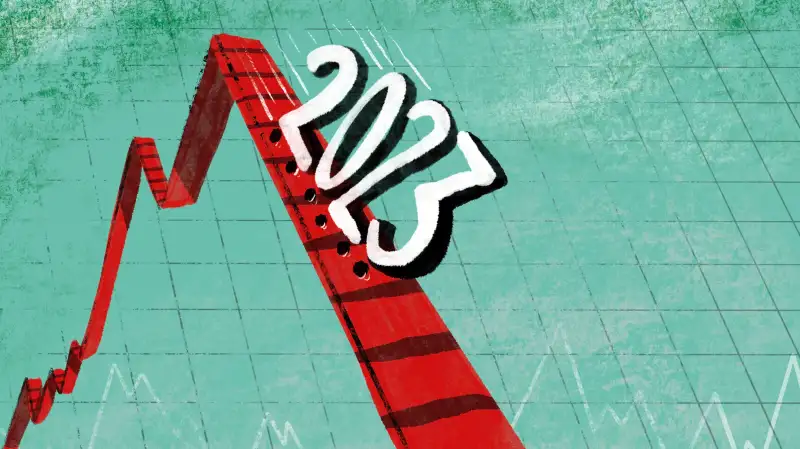What investors should keep in mind in 2023?

What potential investors should keep in mind in 2023. Concerns about rising cases in China and their potential spread to other countries, including India, have temporarily dampened market sentiments, as everyone is still wondering how Covid will affect livelihood and the economy in 2020 and 2021.
If the Russia-Ukraine war, a rise in crude oil prices, inflation, and a sharp increase in interest rates impacted the global economy and markets in 2022, the year is coming to a close with caution due to a potential increase in Covid cases.
Because everyone still remembers how Covid will affect people’s livelihoods and the economy in 2020 and 2021, market sentiment has been temporarily tempered by concerns about the disease’s potential to spread outside of China to other countries, including India, as well as its rising incidence in China.
The benchmark Sensex reached an intraday high of 63,583 on December 1 as markets appeared poised to reach new highs in response to easing retail inflation and growth optimism, but they have since lost nearly 4%, closing at 61,133.88 on December 29.
Market analysts, on the other hand, believe there is hope beyond this, and they are banking on continued private sector investment, a recovery in consumption at the lower end of the economy, and continued capital inflows from foreign portfolio investors who see India as a strategic destination over the next five to ten years.
Investors’ mentality: How serious is the Covid problem?
Covid has transitioned from an unknown-unknown to a known-unknown, so neither the general public, the government, nor the markets are concerned. There is cause for concern, however, because an increase in cases could result in restrictions, slowing the economy’s ongoing recovery. The markets have reacted to this over the last three weeks.
While the government’s and health experts’ predictions of an increase in cases in January are concerning, there is some solace in their prediction that India will not see a large number of hospitalisations or fatalities.

What factors will shape the markets in 2023?
For the economy and markets to thrive, certain critical fundamentals must return to normal. At the top of the list are inflation, the trade deficit, increased consumption, and the preservation of private sector investment. Despite the slowing, inflation remains a concern because it is still above the Reserve Bank of India’s tolerance limit of 6%. Economists believe the central bank will raise interest rates one or two more times before taking a break.
Another issue that many believe Indians must address is the country’s large trade deficit as a result of rising imports and flat export growth. Imports increased by 29.5% to $493.61 billion between April and November 2022, while exports increased by 11% to $295 billion.
As a result, the merchandise trade deficit increased to $198.35 billion from $115.39 billion in the same period the previous year. This could keep the rupee under pressure.
Another significant issue that many raise is the lag in consumption offtake at the bottom of the economy, which is evident in sales of FMCG products and entry-level two-wheelers, among other things. This issue must be addressed in order to promote inclusive growth and economic confidence.
Another important factor will be private sector investment. Although there have been encouraging signs for private investment in a variety of industries, including renewable energy, real estate, and construction, experts believe that a sustained increase in this investment in 2023 will be critical for the Indian economy and markets to continue to grow in the coming years.
How will FPIs act?
Prior to discussing 2023, it is important to highlight some significant advantages that the Indian markets demonstrated in 2022. FPIs withdrew a record Rs 2,17,358 crore from Indian equities in the first half of the year, owing to concerns about the Russia-Ukraine conflict and the Federal Reserve’s decision to accelerate rate hikes in response to the US’s multidecade high inflation levels.
Despite this significant FPI outflow, domestic retail and institutional investors contributed to Indian premier indices remaining largely stable and correcting by nearly 15%. Over the next six months, the Sensex rose by more than 25% to breach 63,000, a level it reached for the first time in November 2022, as FPIs and domestic investors both made net investments totaling more than Rs 98,000 crore.

While this demonstrates the Indian markets’ tenacity, experts argue that it has also driven up their costs to among the highest in the world.
“If international investors seek value investments, they will go to markets where valuations are less expensive. To remain appealing to them, India must be viewed as a strategic location for five to ten years rather than just a place to invest for one to two years. According to Nilesh Shah, MD of Kotak Mahindra Mutual Fund, we will need to demonstrate economic growth, good corporate and political governance, and environmental commitment.
What options are there in 2023?
According to a Motilal Oswal Broking report, Nifty earnings will remain strong in the future and grow at a compound annual growth rate (CAGR) of 17% from FY22 to FY24 as a result of the Centre’s accelerated push toward capital expenditures, expected recovery in private investment, and peaking inflation.
The Sensex, which increased by 3.29 percent in 2022, is expected to continue rising as market volatility persists.
With the impending transition to electric vehicles, the Indian auto industry may be a good long-term investment, whereas FMCG and metal provide strong protection in an inflationary environment.
Due to market uncertainties in the United States, the Indian IT sector has lagged and may continue to be stressed. Furthermore, it implies that domestic market-driven businesses will likely perform better in 2023, particularly in the first half of the year. In the first half of 2023, investors may seek to capitalise on the momentum in the FMCG, auto, and banking sectors.
As the global economy, particularly the United States, begins to show signs of stable recovery, investors may turn their attention to Indian IT and pharmaceutical stocks. The chemicals industry appears to be a wise long-term investment in India as well. According to Mohit Ralhan, CEO of TIW Capital, Indian stocks are expected to continue outperforming other major economies and to return between 10% and 15% in 2023.

What is the debt outlook?
Without a doubt, rising interest rates in the financial system have increased the potential for debt investments.
Since April of this year, the RBI has frontloaded its monetary policy tightening by raising the repo rate by 225 basis points. The yield on benchmark 10-year government bonds increased by 86 basis points to 7.32% the previous year. The central bank is expected to keep fighting to bring retail inflation closer to 4%, and the bond market is already pricing in a 6.5 percent terminal repo rate.
“We believe that the hawkishness of central banks has peaked. According to a fund manager, it’s time to look past the market commotion and identify new bond market opportunities.
edited and proofread by nikita sharma




